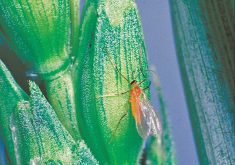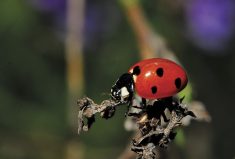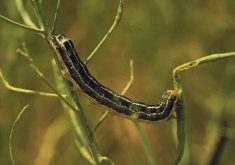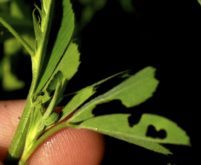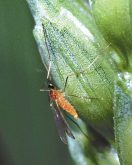Wheat midge, a non-native pest that feeds on developing wheat kernels, is a serious economic threat to farmers, especially in Manitoba and Saskatchewan.
But the pest is now a growing problem in Alberta, including Peace River country, and starting to attack Montana’s wheat crops. However, Agriculture and Agri-Food Canada researchers know ways to reduce its impact.
- More on the Alberta Farmer: Get the facts on wheat midge
Biological controls: Parasitoids
Read Also

Hail research hopes to benefit potato growers
Alberta research scientist measures hail storm and heat dome affects on potato crops
Parasitoids are organisms that live on or in a host and consume it until it eventually dies. Parasitoids that feed on midge have long been known in Canada, with the most widespread type (Macroglenes penetrans) controlling an average of 31.5 per cent of the wheat midge across Saskatchewan. The estimated value of the parasitoid, due to reduction in insecticide costs in Saskatchewan alone, was estimated to be in excess of $248.3 million in the 1990s. The environmental benefits of using a natural predator are a bonus.
In the 1990s, AAFC researchers worked with their counterparts in Switzerland to bring another midge-attacking parasitoid to the country. Platygaster tuberosula was released in prime wheat midge country in eastern Saskatchewan. Through the 2000s, the population grew and has been cohabiting well with the other wheat midge parasitoid. AAFC researchers also developed a refuge (an interspersing of susceptible plants in resistant wheat) strategy for the parasitoids and released midge-tolerant wheat varieties during this time.
Pass the parasitoids, please
Entomologists at Montana State University have seen Canada’s success with parasitoids and visited the Saskatoon Research Centre this month to collect two species of parasitoid wasps from last year’s wheat fields (also known as emergence sites). The timing of their hunting trip is critical, as the parasitoids are only in their adult wasp phase for less than two weeks, which is dependent on seasonal temperatures.
AAFC entomologists will benefit from a successful collection by the Montana team by receiving more data on how these introduced parasitoid populations are faring, the economic impact, and the preservation of the species into the future.
Vigilance required
While parasitoids may seem like a panacea, they must be carefully managed and considered just one of many ways farmers can control wheat midge. The right environment, including frequent crop rotations, applying chemicals at the right time if economically viable, and following other recommended agronomic practices go a long way in supporting the parasitoid population.
“It is important to chemically control wheat midge only when it is economic to do so and only during the susceptible stage in wheats (between heading and flowering), and to implement the ‘refuge’ approach when growing midge-tolerant wheat varieties,” said Owen Olfert, an AAFC expert on invasive insect pests and biodiversity in Saskatoon.



